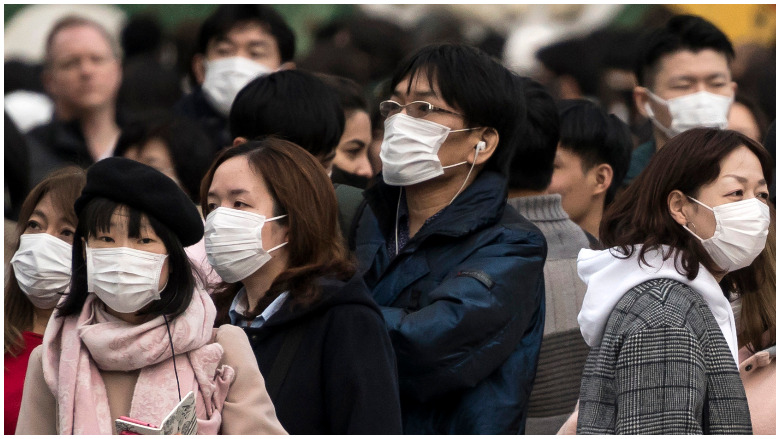
As coronavirus rampages throughout the globe, a lot of people have questions about how it’s transmitted. Among them: Can you get coronavirus from touching objects? Does coronavirus live on surfaces?
To be sure, there’s a lot that’s not known about coronavirus. It’s a relatively new virus on the world stage, and Chinese authorities are notoriously secretive. The Centers for Disease Control & Prevention does say that coronavirus may possibly spread through objects, but this is not believed to be the main way that it spreads.
“The virus that causes COVID-19 seems to be spreading easily and sustainably in the community in some affected geographic areas,” CDC notes.
A recent study found that “viable virus could be detected in aerosols up to 3 hours post aerosolization, up to 4 hours on copper, up to 24 hours on 36 cardboard and up to 2-3 days on plastic and stainless steel…Our results indicate that 40 aerosol and fomite transmission of HCoV-19 is plausible, as the virus can remain viable in aerosols for 41 multiple hours and on surfaces up to days.”
Here’s what you need to know:
Coronavirus Mainly Spreads Through Respiratory Droplets But Can Be Spread By Touching a Surface or Object

GettySecurity guards patrol outside the Huanan Seafood Wholesale Market where the coronavirus was detected in Wuhan on January 24, 2020 – The death toll in China’s viral outbreak has risen to 25, with the number of confirmed cases also leaping to 830, the national health commission said.
The Centers for Disease Control and Prevention has an entire page devoted to how coronavirus spreads. The CDC says:
The virus is thought to spread mainly from person-to-person.
Between people who are in close contact with one another (within about 6 feet).
Through respiratory droplets produced when an infected person coughs or sneezes.
These droplets can land in the mouths or noses of people who are nearby or possibly be inhaled into the lungs.
The CDC does add, though: “It may be possible that a person can get COVID-19 by touching a surface or object that has the virus on it and then touching their own mouth, nose, or possibly their eyes, but this is not thought to be the main way the virus spreads.”
According to CDC, “CDC is responding to an outbreak of respiratory disease caused by a novel (new) coronavirus that was first detected in China and which has now been detected in almost 90 locations internationally, including in the United States. The virus has been named ‘SARS-CoV-2’ and the disease it causes has been named ‘coronavirus disease 2019’ (abbreviated ‘COVID-19’).”
CDC concludes, “While information so far suggests that most COVID-19 illness is mild, a reportexternal icon out of China suggests serious illness occurs in 16% of cases. Older people and people of all ages with severe underlying health conditions — like heart disease, lung disease and diabetes, for example — seem to be at higher risk of developing serious COVID-19 illness.”
According to CDC, “Early on, many of the patients at the epicenter of the outbreak in Wuhan, Hubei Province, China had some link to a large seafood and live animal market, suggesting animal-to-person spread. Later, a growing number of patients reportedly did not have exposure to animal markets, indicating person-to-person spread. Person-to-person spread was subsequently reported outside Hubei and in countries outside China, including in the United States. Some international destinations now have apparent community spread with the virus that causes COVID-19, as do some parts of the United States. Community spread means some people have been infected and it is not known how or where they became exposed.”
What about from food? Read on.
CDC Says There is ‘Likely Very Low Risk’ of Spread From Food Products

GettyTourist wearing protective respiratory masks tour St. Peter’s Square prior to the Pope’s weekly Angelus prayer on February 2, 2020 in the Vatican.
The Centers for Disease Control and Prevention says that there is currently no evidence to support transmission through food.
“Coronaviruses are generally thought to be spread from person-to-person through respiratory droplets. Currently there is no evidence to support transmission of COVID-19 associated with food. Before preparing or eating food it is important to always wash your hands with soap and water for 20 seconds for general food safety. Throughout the day wash your hands after blowing your nose, coughing or sneezing, or going to the bathroom,” CDC explains.
“It may be possible that a person can get COVID-19 by touching a surface or object that has the virus on it and then touching their own mouth, nose, or possibly their eyes, but this is not thought to be the main way the virus spreads. In general, because of poor survivability of these coronaviruses on surfaces, there is likely very low risk of spread from food products or packaging that are shipped over a period of days or weeks at ambient, refrigerated, or frozen temperatures.”
Harvard Medical School posed the question many are asking: “Can I catch the coronavirus by eating food prepared by others?”
According to Harvard Medical School, “We are still learning about transmission of COVID-19. It’s not clear if this is possible, but if so it would be more likely to be the exception than the rule. That said, COVID-19 and other coronaviruses have been detected in the stool of certain patients, so we currently cannot rule out the possibility of occasional transmission from infected food handlers. The virus would likely be killed by cooking the food.”
The Food Safety Authority of Ireland offers similar advice, saying, “Experience with SARS and MERS suggest that people are not infected with the virus through food. So, it is unlikely the virus is passed on through food and there is no evidence yet of this happening with COVID-19 (coronavirus) to date. Coronaviruses need a host (animal or human) to grow in and cannot grow in food. Thorough cooking is expected to kill the virus because we know that a heat treatment of at least 30min at 60ºC is effective with SARS.”
READ NEXT: Can Pets Get Coronavirus?